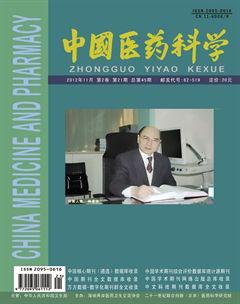胰高血糖素样肽—1的生物学及相关药物研究
李磊 李立安
[摘要] 19世纪60年代发现了肠道对葡萄糖具有调节作用。这种生理现象主要是由两个被称为“肠促胰素”的肠内因子:胰高糖素样肽-1(7-37)/(7-36)酰胺和葡萄糖依赖性促胰岛素多肽(1-42)介导的。GLP-1与GLP-1受体的结合,刺激cAMP生成,增加葡萄糖依赖性胰岛素分泌。研究还证明在体外人的胰岛制备中,GLP-1介导β-细胞凋亡的减弱和胰岛素反应性增强。很明显GLP-1/GLP-1受体轴是葡萄糖代谢的关键性生理调节器,因此GLP-1受体激动剂和DPP-4抑制剂成为治疗糖尿病药物研发的焦点。
[关键词] 肠促胰素效应;葡萄糖依赖性促胰岛素多肽;胰高血糖素样肽-1;GLP-1受体激动剂;二肽基肽酶-4抑制剂;糖尿病
[中图分类号] R977.1???[文献标识码] A???[文章编号] 2095-0616(2012)21-58-02
Botanical and pharmaceutical research on glucagon-like peptide-1
LI?Lei1??LI?Li'an2
1.Outpatient Department, Art College of the PLA, Beijing 100081,China;2.Department of Gynaecology and Obstetrics, PLA General Hospital, Beijing 100853,China
[Abstract] The regulating effect of intestinal on glucose was found in 1960s.This physiologic phenomenon is primarily mediated by two enteric factors going by the name of the incretins: glucagon-like peptide-1 (7-37)/(7-36)-amide (GLP-1) and glucose dependent insulinotropic polypeptide (1-42). The combination of GLP-1 with GLP-1 receptor stimulates the production of cAMP and enhances the secretion of Glucose dependent insulin. It also demonstrates GLP-1 mediateds the attenuation of β-cell apoptosis and enhances the responsiveness of insulin in an?ex vivo?human islet preparation. It is clear the GLP-1/GLP-1 receptor axis is a key physiologic regulator of glucose metabolism. Therefore GLP-1 agonists and DPP-4 inhibitor become the focus of reserch and development on diabetes drugs.
[Key words] Incretin effect;Gastric inhibitory polypeptide;Glucagon-like peptide-1;GLP-1 receptor agonists; Ddipeptidyl peptidase-4 inhibitors; Diabetes mellitus
肠促胰素(incretin)的发现开启了糖尿病治疗的新篇章,早在上世纪60年代,Mcintyre N等[1-2]发现,口服葡萄糖对胰岛素分泌的促进作用明显高于静脉注射,证明了肠道对葡萄糖的调节作用,提出了“肠促胰素效应”(incretin effect)。而Perley等证实,这种“肠促胰素效应”所产生的胰岛素占进食后胰岛素总量的50%以上。肠促胰素由两种多肽组成。一种命名为葡萄糖依赖性促胰岛素多肽(gastric inhibitory polypeptide,GIP)(1-42)。另一种为胰高血糖素样多肽-1(glucagon-like peptide-1,GLP-1)。T2DM肠促胰岛素效应降低表现为对GIP的治疗的抵抗[3]和进餐后GLP-1浓度升高幅度较正常人减小。而注射GLP-1引起强大的胰岛素分泌反应并使血糖正常化[4],因此GLP-1及其类似物可以作为2型糖尿病治疗的一个重要靶点。本资料仅就GLP-1的生物学及有关的药物研究做一下介绍。
1?GLP-1的生理作用
释放进入血液循环的GLP-1直接作用于胰岛,以葡萄糖浓度依赖性方式促进胰岛β细胞分泌胰岛素(insulin),主要通过以下几方面发挥降糖作用。(1)GLP-1通过G蛋白激活腺苷酸环化酶(AC),使cAMP水平升高,促进胰岛素基因的转录、胰岛素的合成和分泌,并可刺激胰岛β细胞的增殖和分化,抑制胰岛β细胞凋亡,增加胰岛β细胞数量[5]。作用于胰岛α细胞,抑制胰高血糖素的释放,作用于胰岛δ细胞,促进生长抑素的分泌,而生长抑素又可作为旁分泌激素参与抑制胰高血糖素的分泌。(2)GLP-1作用于中枢神经系统,抑制胃肠道蠕动和胃液分泌,抑制食欲及摄食,延缓胃内容物排空,使人产生饱胀感和食欲下降,从而使体重减轻。(3)GLP-1对心血管的作用已吸引了极大注意力。降低血压、改善脂质和内皮/心肌功能,而且有可能改善心血管疾病的预后。最新动物模型的数据表明,GLP-1的心脏保护和血管舒张作用(7-36)是不依赖于已知的GLP-1R,而是至少部分是由其代谢物GLP-1(9-36)介导的[6]。更令人兴奋的是它对中枢神经系统的影响。最新的临床前数据显示了GLP-1的神经保护/神经营养功能,或许有可能停止/或逆转中枢神经系统疾病如阿尔茨海默病(Alzheimer's disease)的神经退行性疾病[7]。
2?GLP-1受体(GLP-1R)
GLP-1的生理功能主要是通过激活细胞表面的GLP-1受体(GLP-1R)而引发的。GLP-1是α-螺旋肽,通过与GLP-1R的细胞外多个接触点结合并相互作用引起受体信号[8]。GLP-1R是B族G蛋白偶联受体(GPCRs),包括N端区域和中心区域两部分。GLP-1R的N端区域保存了α-β-βα蛋白质组成的3层折叠的B1级GPCRs,这种结构,简称为“胞外域”(ECD)。GLP-1R利用N-末端的胞外域(ECD)作为“亲和力陷阱(affinity trap)”以识别并结合肽类配体[8]。GLP-1与受体结合过程可归为两步走:第1步是GLP-1的C端与受体N端结合,第2步则是N端与受体中心区域结合而激活受体。GLP-1的His7等残基为其与受体结合的关键位点[9],而GLP-1R的N端的Trp残基对配体的亲和力有重要影响。
3?作用于GLP-1R的药物研究
随着肠促胰岛素激素领域取得的重要进展及对GLP-1葡萄糖依赖性促胰岛素的分泌和在2型糖尿病病理学中的作用的认识,以及天然的GLP-1被无处不在的蛋白酶DPP-4迅速降解的发现,导致了对DPP-4降解抵抗的GLP-1R激动剂和DPP-4活性的选择性抑制剂作为治疗药物的研发。
3.1?GLP-1受体肽类激动剂
改善GLP-1类似物代谢特性的常见方法是在N-末端引入取代基团进行修饰以减少对DPP-4的灵敏度[10]。到目前为止,通过置换天然的GLP-1肽链中的氨基酸,以研发作用时间长的分子已取得了成功。艾塞那肽(exenatide)和利拉鲁肽(liraglutide)已获得多个政府监管机构批准上市用于治疗T2DM。
艾塞那肽是一个39个氨基酸肽的GLP-1R激动剂,在细胞分析和与天然GLP-1受体竞争性结合研究中证明是充分有效的[11]。它较GLP-1有更长的作用时间,生物半衰期约为4 h。2005年4月,艾塞那肽以商品名Byetta成为第1个由美国食品和药物管理局(FDA)批准用于治疗T2DM的GLP-1类似物。利拉鲁肽这种分子,“脂肪酸衍生”策略被用来延长GLP-1在体内的作用。利拉鲁肽的血浆消除半衰期为11~15 h[12]。利拉鲁肽商品名Victoza,在2010年1月由FDA批准上市用于治疗T2DM。
3.2?二肽基肽酶-4(DPP-4)抑制剂
现在已研发的DPP-4抑制剂有西他列汀(sitagliptin)、维格列汀(vildagliptin)、沙格列汀(saxagliptin)和利格列汀(linagliptin)。与GLP-1受体激动剂必须按时皮下注射不同,它们的共同特点是口服有效,因而倍受糖尿病患者的欢迎。
DPP-4抑制剂没有GLP-1受体激动剂减缓胃排空、增加果腹感、促进适度减肥的作用[13]。可能是由于DPP-4抑制剂阻断了多肽如GIP和神经肽Y的降解,以及对胃蠕动和中枢神经系统(CNS)对食欲的控制发挥相反的影响[14],故DPP-4抑制剂vildagliptin能显著降低低血糖的发病率,老年患者(年龄>65岁)此作用更为明显。从目前的临床数据看,GLP-1类似物升高GLP-1水平、降低HbA1C和餐后血糖的效果很可能优于DPP-4抑制剂,并可较DPP-4抑制剂更有效地发挥延迟胃排空、减少热量摄入和改善胰岛功能等作用。
随着肠促胰素,特别是胰高血糖素样肽-1的生物学的进一步阐明,以及新的以胰高血糖素样肽-1为靶点的药物的不断涌现,为糖尿病的治疗产生了新的理念。血糖达标率低是全球面临的共同难题,我国糖尿病患者中仅有不到1/3的人达标。世界范围内大约80%的2型糖尿病患者糖化血红蛋白无法控制在7%以内。原因是传统降糖药物不能有效地保护β-细胞,使得β-细胞分泌胰岛素的功能逐渐减退。而以GLP-1为靶点的药物能够刺激胰岛β细胞的增殖和分化,抑制胰岛β细胞凋亡,增加胰岛β细胞数量,促进胰岛素的合成和分泌,因而可长期稳定的控制血糖水平,为糖尿病患者带来了新的希望。
[参考文献]
[1] Mcintyre N,Holdsworth CD,Turner DS.New interpretation of oral glucose tolerance[J].The Lancet,1964,2(7349):20-21.
[2] Elrick H,Stimmler L,Hlad CJ,et al.Plasma insulin response to oral and intravenous glucose administration[J].The Journal of Clinical Endocrinology & Metabolism,1964,24:1076-1082.
[3] Krarup T,Saurbrey N,Moody AJ.Effect of porcine gastric inhibitory polypeptide on beta-cell function in type I and typeⅡ diabetes mellitus[J].Metabolism,1987,36(7):677-682.
[4] Nauck MA,Kleine N,Orskov C,et al.Normalisation of fasting hyperglycaemia by exogenous glucagon-like peptide 1(7–36 amide)in type 2(non-insulin-dependent) diabetic patients[J].Diabetologia,1993,36:741-744.
[5] Islam D,Zhang N,Wang P,et al.Epac is involved in cAMP stimulated proglucagon expression and hormone production but not hormone secretion in pancreatic alpha and intestinal L cell lines[J].Am J Physiol Endocrinol Metab,2009,296(1):174-181.
[6] Ban K,Noyan-Ashraf MH,Hoefer J,et al.Cardioprotective and vasodilatory actions of glucagon-like peptide 1 receptor are mediated through both glucagon-like peptide 1 receptor-dependent and -independent pathways[J].Circulation,2008,117:2340-2350.
[7] Li Y,Duffy KB,Ottinger MA et al.GLP-1 receptor stimulation reduces amyloid-beta peptide accumulation and cytotoxicity in cellular and animal models of Alzheimer's disease[J].J Alzheimers Dis,2010,19:1205-1219.
[8]?Underwood CR,Garibay P,Knudsen LB,et al.Crystal structure of glucagon-like peptide-1 in complex with the extracellular domain of the glucagon-like peptide-1 receptor[J].The Journal of Biological Chemistry,2010,285(1):723-730.
[9] Xiao Q,Giguere J,Parisien M,et al.Biological activities of glucagon-like peptide-1 analogues in vitro and in vivo[J].Bioiochem,2001,40(9):2860-2869.
[10]?Siegel EG,Gallwitz B,Scharf G,et al.Biological activity of GLP-1-analogues with N-terminal modifications[J].Regulatory Peptides,1999,79(2-3):93-102.
[11] Goke R,Fehmann HC,Linn T,et al.Exendin-4 is a high potency agonist and truncated exendin-(9–39)-amide an antagonist at the glucagon-like peptide 1-(7–36)-amide receptor of insulin- secreting beta-cells[J].The Journal of Biological Chemistry,1993,268(26):19650-19655.
[12] Elbrond B,Jakobsen G,Larsen S,et al.Pharmacokinetics,pharmacodynamics,safety,and tolerability of a single-dose of NN2211,a long-acting glucagon-like peptide 1 derivative,in healthy male subjects[J].Diabetes Care,2002,25(8):1398-1404.
[13] Drucker DJ,Nauck MA.The incretin system:glucagon-like peptide-1 receptor agonists and dipeptidyl peptidase-4 inhibitors in type 2 diabetes[J].The Lancet,2006,368:1696-1705.
[14] Nauck MA.Incretin-based therapies for type 2 diabetes mellitus:properties,functions,and clinical implications[J].Am J Med,2011,124(1Suppl):S3-18.
(收稿日期:2012-09-14)

